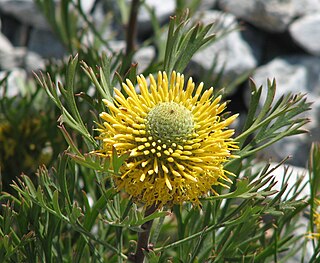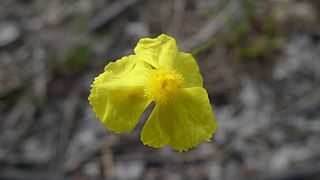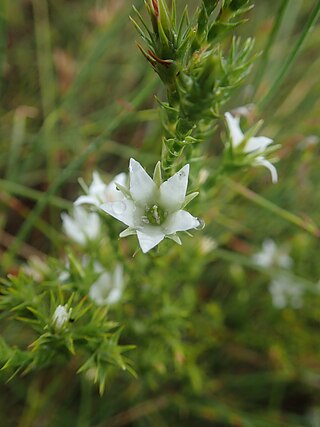
Toona, commonly known as redcedar, toon or toona, tooni is a genus in the mahogany family, Meliaceae, native from Afghanistan south to India, and east to North Korea, Papua New Guinea and eastern Australia. In older texts, the genus was often incorporated within a wider circumscription of the related genus Cedrela, but that genus is now restricted to species from the Americas.

Xyris is a genus of flowering plants, the yelloweyed grasses, in the yellow-eyed-grass family. The genus counts over 250 species, widespread over much of the world, with the center of distribution in the Guianas.

Isopogon anemonifolius, commonly known as broad-leaved drumsticks, is a shrub of the family Proteaceae that is native only to eastern New South Wales in Australia. It occurs naturally in woodland, open forest, and heathland on sandstone soils. I. anemonifolius usually ranges between one and two metres in height, and is generally smaller in exposed heathland. Its leaves are divided and narrow, though broader than those of the related Isopogon anethifolius, and have a purplish tinge during the cooler months. The yellow flowers appear during late spring or early summer and are displayed prominently. They are followed by round grey cones, which give the plant its common name drumsticks. The small hairy seeds are found in the old flower parts.

Toona ciliata is a forest tree in the mahogany family which grows throughout South Asia from Afghanistan to Papua New Guinea and Australia.

Acacia complanata, known as long-pod wattle and flat-stemmed wattle, is a perennial tree native to eastern Australia.

Diphasiastrum complanatum, common names groundcedar, creeping jenny, or northern running-pine, is a species of clubmoss native to dry coniferous forests in colder northerly parts of the world. Under the original name Lycopodium complanatum, this was an inclusive superspecies that included a number of other species now known to be biologically separate. This plant is an evergreen, perennial pteridophyte. The spores are produced June to September.

Ageratina adenophora, commonly known as Crofton weed, is a species of flowering plant in the family Asteraceae native to Mexico and Central America. Originally grown as an ornamental plant, it has become invasive into farmland and bushland worldwide. It is toxic to horses, which develop a respiratory disease known as Numinbah horse sickness after eating it.

Olea paniculata, commonly known as the native olive, is a plant of the genus Olea and a relative of the olive. It grows natively in Pakistan and southwestern China (Yunnan) through tropical Asia to Australia and the Pacific islands of New Caledonia, Vanuatu and Lord Howe Island.

Paratrophis pendulina is a species of flowering plant in the mulberry family, Moraceae. In Australia it is commonly known as whalebone tree, and other common names include the white handlewood, axe-handle wood, grey handlewood and prickly fig. In Hawaii it is known as Hawai'i roughbush or aʻiaʻi in Hawaiian.

Pteris tremula, commonly known as Australian brake, tender brake, tender brakefern, shaking brake is a fern species of the family Pteridaceae native to sheltered areas and forests in eastern Australia and New Zealand. It has pale green, lacy fronds of up to 2 meters in length. It is fast-growing and easy to grow in cultivation, but can become weedy.

Commersonia dasyphylla, commonly known as kerrawang, is a species of flowering plant of the family Malvaceae and is endemic to eastern continental Australia. It is a shrub with egg-shaped to lance-shaped with irregular edges and flowers in groups of up to 21, followed by hairy brown capsules.

Epacris microphylla , commonly known as coral heath, is a plant in the heath family Ericaceae and which is endemic to eastern Australia. It is a common, wiry shrub with tiny leaves that are often obscured by the flowers, especially near the ends of the stems. The plant sometimes grows in dense groups, giving the effect of a snowfall.

Secamone elliptica, also known as corky milk vine, cork vine and secamone, is a species of vines or lianas, of the plant family Apocynaceae. The range extends from southern China through much of Southeast Asia to Northern Australia, from The Kimberley, across The Top End and the East coast from Cape York to northern New South Wales. The natural habitat is monsoon forest, littoral rainforest and occasionally in more open forest types.

Xyris torta, the slender yelloweyed grass, is a North American species of flowering plant in the yellow-eyed-grass family. It is widespread in the central and eastern United States from New Hampshire to Georgia, west as far as Minnesota, Nebraska, and eastern Texas.

Oberonia complanata, commonly known as the southern green fairy orchid or yellow-flowered king of the fairies, is a plant in the orchid family and is a clump-forming epiphyte. It has between three and eight leaves in a fan-like arrangement on each shoot and up to three hundred tiny cream-coloured or greenish flowers arranged in whorls around the flowering stem. It is endemic to eastern Australia.

Xyris gracilis, commonly known as slender yellow-eye, is a species of flowering plant in the family Xyridaceae and is endemic to eastern Australia. It is a tufted herb with linear leaves with 5 to 8 flowering stems with bright yellow flowers.

Xyris juncea, the dwarf yellow-eye, is a species of flowering plant found in northern and eastern Australia. It is widespread in swampy areas. It is a tufted herb, growing up to 30 cm high. This is one of the many plants first published by Robert Brown with the type known as "(J.) v.v." Appearing in his Prodromus Florae Novae Hollandiae et Insulae Van Diemen in 1810. The specific epithet juncea is derived from Latin, meaning a resemblance to a sedge.

Xyris bracteata is a yellow-eye which grows in dry or wet heath, or in open eucalyptus woodland with a heath understorey. Only found in eastern New South Wales, Australia, it is a robust erect herb, growing up to 60 cm high. This is one of the many plants first published by Robert Brown, with the type known as "(J.) v.v.", appearing in his Prodromus Florae Novae Hollandiae et Insulae Van Diemen in 1810. The specific epithet bracteata is derived from Latin, meaning "having bracts."

Sprengelia sprengelioides is a species of flowering plant of the family Ericaceae, and is endemic to near-coastal areas of eastern Australia. It is an erect shrub with egg-shaped leaves, and white flowers arranged singly in leaf axils.

Eurychorda is a monotypic genus of flowering plants in the family Restionaceae formally described in 1998. The only known species, Eurychorda complanata, commonly known as the flat cord-rush, is endemic to Australia. It is characterised by flattened stems and reduced, sheathing leaves.





















